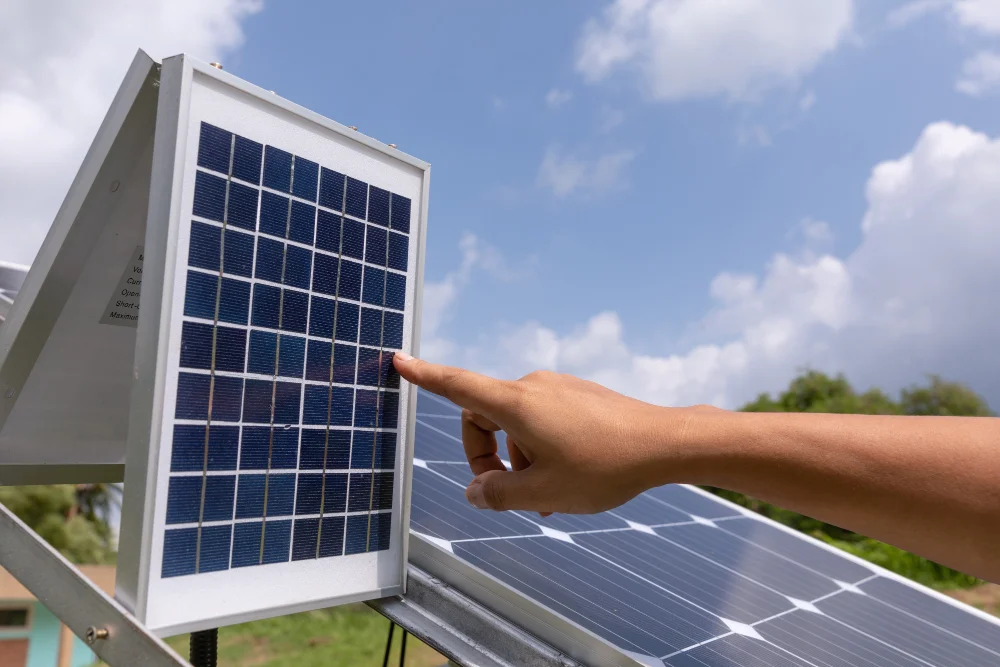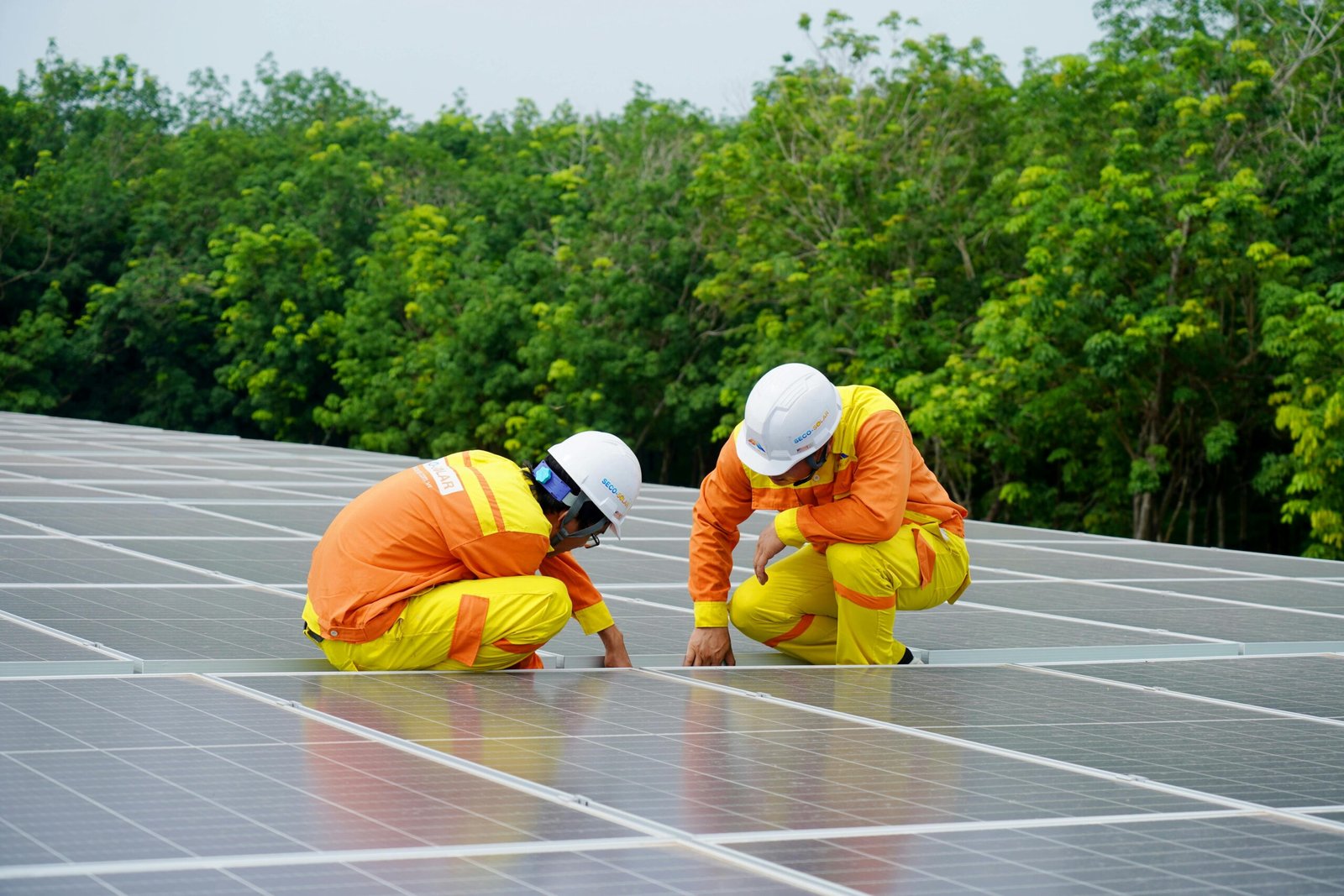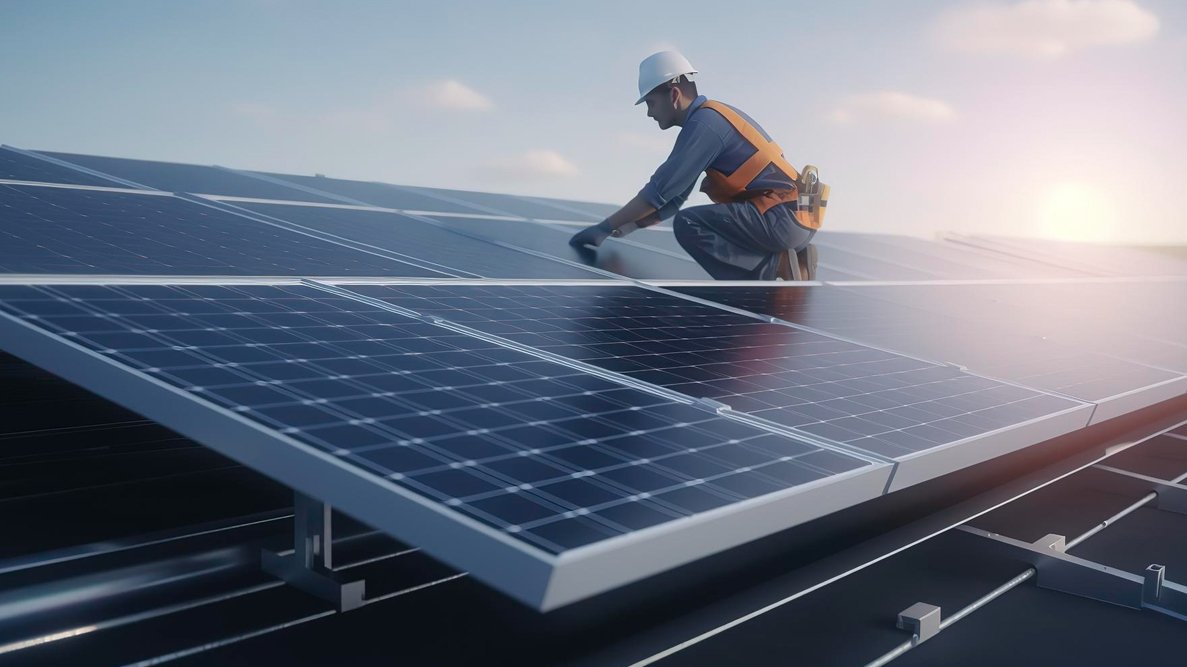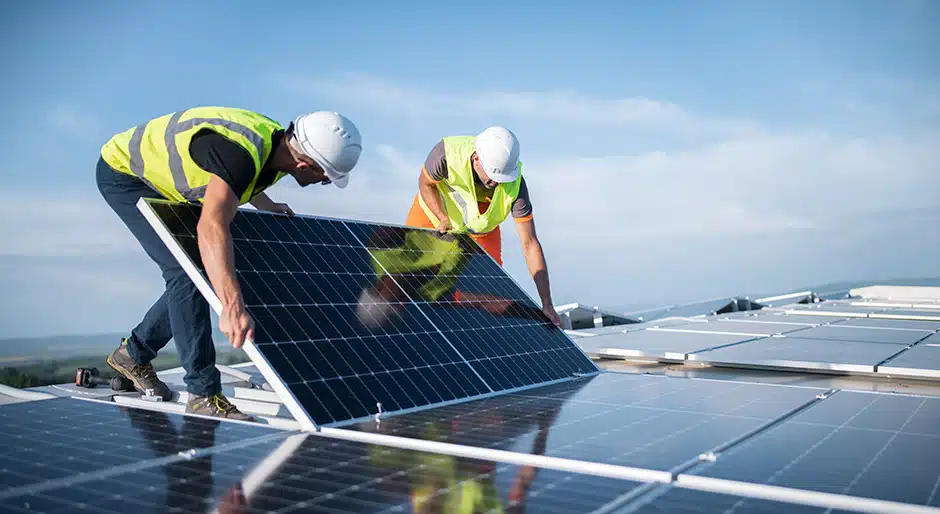Energy is one of the largest recurring costs for commercial and industrial businesses. Add to that the volatility of grid prices, increasing demand for clean energy, and global sustainability mandates, and the answer becomes clear: solar rooftops are no longer optional—they’re essential.
But before investing in a rooftop solar system, there are many things businesses should carefully evaluate. From technical feasibility to financing, policy benefits, and operational considerations, making the right choices upfront ensures that your solar investment delivers maximum savings and long-term reliability.
Table of Contents
This blog is your ultimate guide — covering everything you need to know before installing a solar rooftop system.
What is a Solar Rooftop System?
A solar rooftop system, also known as a rooftop solar PV system, consists of solar panels and related equipment installed on a building’s roof—this can encompass industrial, commercial, institutional, or residential structures. The primary function of these systems is to harness sunlight to generate electricity, which can be utilized for onsite power consumption, thereby diminishing reliance on the electrical grid. Additionally, these systems may allow users to sell excess power back to the grid.
Many configurations incorporate energy storage solutions, enhancing their reliability during power outages. The solar panels collect solar energy and convert it into electricity, benefiting various applications such as operating machinery, lighting, and climate control systems. Essentially, solar rooftop systems transform otherwise unused rooftop areas into efficient solar energy generation sites, promoting both cost savings and clean energy production.
Key Components of a Solar Rooftop System
| Component | Role / Why It Matters |
|---|---|
| PV Modules / Solar Panels | These are the heart of the system. They convert sunlight (photons) into Direct Current (DC) electricity. Their efficiency, durability, temperature behavior, etc., determine how much power your rooftop can generate per square meter. |
| Inverter(s) | Converts the DC electricity generated by panels into Alternating Current (AC), which is usable by your machinery, lighting, HVAC, etc. The type (string, central, microinverter, hybrid) affects performance, cost, shading resilience. |
| Mounting / Racking Structure | Fixes the panels securely to the rooftop. Must handle structural loads (weight, wind), angle and direction for optimal sun exposure, and ensure structural integrity of your roof. |
| Electrical Components (Wiring, Cabling, Protectives, Safety Gear) | Includes cables, junction boxes, switchgear, earthing (grounding), surge protectors, etc. They ensure safe, reliable transmission of electricity from panels to inverter to loads/grid. Weather/resilience and safety standards matter. |
| Monitoring & Metering Systems | Allows tracking of generation, performance losses, faults. In many grid-connected systems, net metering or bi-directional metering is used to measure what you draw vs. what you export. |
| Optional: Battery Storage | If you want backup power during grid outages, or to shift consumption (use solar power during peak tariff hours, or store for night use), batteries become important. Adds cost and complexity but improves reliability / energy independence. |
Types of Rooftop Solar Systems
On-grid system
The rooftop solar system is integrated with the public utility grid, utilizing solar generation during daylight and drawing power from the grid when needed. It consists of solar PV panels, grid-tie inverters, wiring, and monitoring systems. Benefits include lower upfront costs, easier maintenance, quicker ROI through savings and potential sell-back of surplus energy, and regulatory incentives. However, it has limitations, such as no power during outages, dependence on favorable net-metering policies, and potential performance issues in areas with grid instability. The market has shifted significantly toward grid-connected systems, with over 98% of solar cell production in 2016 being allocated to this category.
Off-grid system
The rooftop solar system operates independently from the utility grid, relying on solar energy and storage (battery bank) to meet electricity demands. It is suitable for locations with unreliable or non-existent grid access and where energy self-reliance is necessary. Key components include solar PV panels, battery storage, off-grid inverters, and backup power sources. Advantages include energy independence, elimination of utility bills, and cost savings against tariff hikes. However, challenges include high initial costs, complexity in system sizing, significant maintenance and lifecycle costs for batteries, and risks associated with improper sizing that can lead to outages.
Hybrid System
A hybrid system integrates grid-connected and off-grid features, utilizing solar, battery, and grid resources. It includes solar panels, hybrid inverters, a battery bank, and a control system to manage energy sources. Advantages include improved resilience, better energy utilization, flexibility in operation, and potential long-term savings despite higher initial costs. Challenges involve higher capital expenses, design complexity, battery maintenance impacts on operational costs, and regulatory considerations concerning grid feeding and safety standards.

Possibility of using rooftops to generate electricity
Technical Potential: How Much Rooftops Can Generate
India’s residential rooftops have a technical solar capacity potential of approximately 637 GW, according to a report by the Council on Energy, Environment and Water (CEEW). However, when factoring in actual electricity consumption, only around 118 GW is realistically achievable without subsidies. Currently, the total installed rooftop solar capacity across all sectors in India stands at about 11 GW, which is a minor fraction of the potential. In terms of output, 1 kW-peak (kWp) of solar panels generates roughly 4 to 5 kWh per day, influenced by factors such as solar irradiation and shading. Generally, about 10 square meters (approximately 100-120 square feet) of unobstructed roof space is required to install 1 kWp of solar panels.
Opportunities: Why Rooftops Make Sense
For industrial and commercial units, particularly those with large flat or low-tilt roofs such as factories and warehouses, the installation of rooftop solar systems presents several advantages. These roofs are ideally suited for high-capacity installations with minimal structural modifications. One of the main economic benefits is the substantial reduction in electricity costs, particularly during peak hours when tariff rates are elevated. This is crucial for industries with high and consistent electricity needs. Additionally, rooftop solar enhances energy security by decreasing dependence on grid electricity, thereby lessening the impact of grid outages and fluctuations in voltage or tariffs.
Governments often support this transition through various regulatory incentives, including subsidies and favorable policies for net-metering and feed-in tariffs, which can enhance financial returns. Furthermore, adopting rooftop solar aligns with environmental, social, and governance (ESG) goals, as it helps companies meet sustainability targets by reducing carbon emissions and bolstering their brand image in an increasingly eco-conscious marketplace.
How much of the rooftop should be used?
Determining the effective solar panel usage on rooftops involves several critical considerations. The usable rooftop area must be free from shade, structurally sound, safe for access, and oriented to maximize solar exposure. Obstructions like HVAC units, chimneys, ducts, skylights, and surrounding buildings impact the available installation area. Typically, on large flat rooftops with few obstructions, 60–80% of the total area can be utilized. In contrast, roofs with moderate obstructions and shading allow for 50–70% usage, while complex roofs may only permit 30–50% usability.
A guideline in regions like India suggests that 10–12 square meters of clear rooftop space is necessary for every 1 kW of installed solar capacity. The efficiency of the solar panels can affect the space required, where high-efficiency panels may decrease needs, while issues like poor orientation can increase the area needed. For instance, a factory with a 5,000 m² roof that has a 60% usable area due to obstructions could accommodate a 300 kWp solar system.
Decision-makers must also evaluate energy requirements, roof strength, maintenance access, potential future expansions, and local regulations that could restrict rooftop installations. Comprehensive planning is essential to ensure the solar system optimizes energy generation while adhering to safety standards. Overall, most industrial and commercial roofs can typically utilize 50–80% of their space effectively, transforming rooftops into valuable energy resources.

Cost Benefit of Solar Rooftop
1. Capital Expenditure (CAPEX) and Subsidies
The initial investment for a rooftop solar system varies based on capacity and location. For instance, a 5 kW system in Delhi may cost approximately ₹1.5 lakh after subsidies. Government initiatives like the PM Surya Ghar Muft Bijli Yojana provide subsidies up to ₹78,000 for systems up to 3 kW, significantly reducing upfront costs.
2. Return on Investment (ROI) and Payback Period
The payback period for rooftop solar systems in India typically ranges between 2.5 to 5 years, depending on factors such as system size, electricity tariffs, and energy consumption patterns. For example, a 5 kW system generating 7,000 units annually at an electricity rate of ₹8 per unit can save around ₹56,000 annually, leading to a payback period of approximately 2.7 years. Post payback, the system continues to generate savings for over 20 years.
3. Long-Term Savings
Over a 25-year lifespan, a rooftop solar system can yield substantial savings. For instance, a 5 kW system with annual savings of ₹56,000 can accumulate over ₹30 lakh in savings over its lifetime. These savings are bolstered by rising electricity tariffs and potential revenue from surplus energy exported to the grid.
4. Environmental and Social Impact
Adopting rooftop solar contributes to environmental sustainability by reducing carbon emissions. For example, Gujarat’s implementation of the PM Surya Ghar scheme has led to the installation of over 3.3 lakh rooftop solar systems, generating 1,232 MW of solar energy and preventing the emission of 1,504 metric tonnes of CO₂.
5. Additional Financial Incentives
Recent policy changes, such as the reduction of Goods and Services Tax (GST) on solar photovoltaic modules and wind turbine generators from 12% to 5%, have further decreased the capital costs for solar projects, enhancing the financial viability of rooftop solar installations.
Is solar energy a good fit for your home?
Solar rooftop energy can be an excellent fit for your home, especially if your roof receives good sunlight and has minimal shading. Installing a rooftop solar system allows you to generate your own electricity, significantly reduce your monthly energy bills, and even sell excess power back to the grid through net-metering. Government incentives and subsidies make the upfront investment more affordable, while high-quality solar panels can last 25 years or more, providing long-term savings. Additionally, rooftop solar contributes to environmental sustainability by reducing your carbon footprint and reliance on fossil fuels. Factors such as roof orientation, available space, energy consumption, and budget should be considered, but for most households, rooftop solar is a smart, cost-effective, and environmentally friendly energy solution.

Future of Solar Rooftop
The future of solar rooftop energy in India is extremely promising, fueled by a combination of supportive government policies, technological advancements, and increasing public awareness. Government initiatives such as the Pradhan Mantri Surya Ghar Muft Bijli Yojana aim to provide solar rooftop systems to millions of households through subsidies, while programs like PM KUSUM support farmers with solar pumps and grid-connected solar rooftop installations, aligning with India’s commitment to achieving net-zero emissions by 2070.
The solar rooftop market in India has been expanding rapidly, with record additions of capacity in recent years, and projections indicate growth from 17.6 GW in 2025 to 41.5 GW by 2030 at a compound annual growth rate of 18.7%. Technological improvements, including higher-efficiency solar panels and advanced energy storage solutions, are enhancing the performance and viability of solar rooftop systems. Economically, these systems enable households and businesses to reduce electricity bills and, in some cases, earn revenue by selling surplus energy back to the grid.
Environmentally, widespread adoption of solar rooftop installations contributes to lowering carbon emissions and supports India’s transition to sustainable energy. While challenges such as regulatory hurdles, financing constraints, and grid interconnection issues remain, ongoing efforts to streamline processes, improve infrastructure, and enhance financing options are helping overcome these obstacles. With continued policy support and innovation, solar rooftop energy is poised to play a transformative role in India’s energy landscape, delivering long-term economic, environmental, and societal benefits.
Conclusion
In conclusion, solar rooftop systems offer an unparalleled opportunity for homes, businesses, and industries to harness clean, reliable, and cost-effective energy. By transforming unused roof space into a productive asset, these systems reduce electricity bills, provide energy security, and contribute significantly to environmental sustainability. With supportive government policies, attractive incentives, and advances in solar technology, the adoption of solar rooftop solutions in India is set to accelerate rapidly in the coming years. Embracing solar rooftop energy is not just an investment in infrastructure—it is an investment in long-term savings, operational efficiency, and a greener future.
For homeowners and businesses ready to make the transition, now is the perfect time to explore tailored solar rooftop solutions that maximize both financial and environmental benefits. Take the step today and let your rooftop become a source of clean, sustainable energy for years to come. Ready to turn your rooftop into a source of clean, cost-saving energy? Contact us today to explore customized solar rooftop solutions for your home or business and start maximizing savings while contributing to a greener future.
